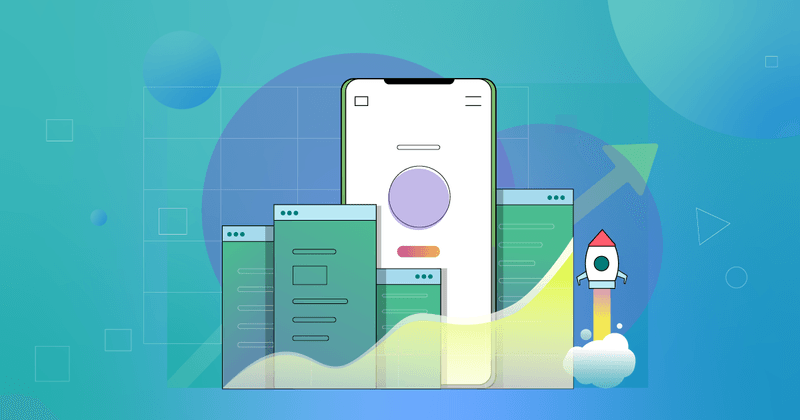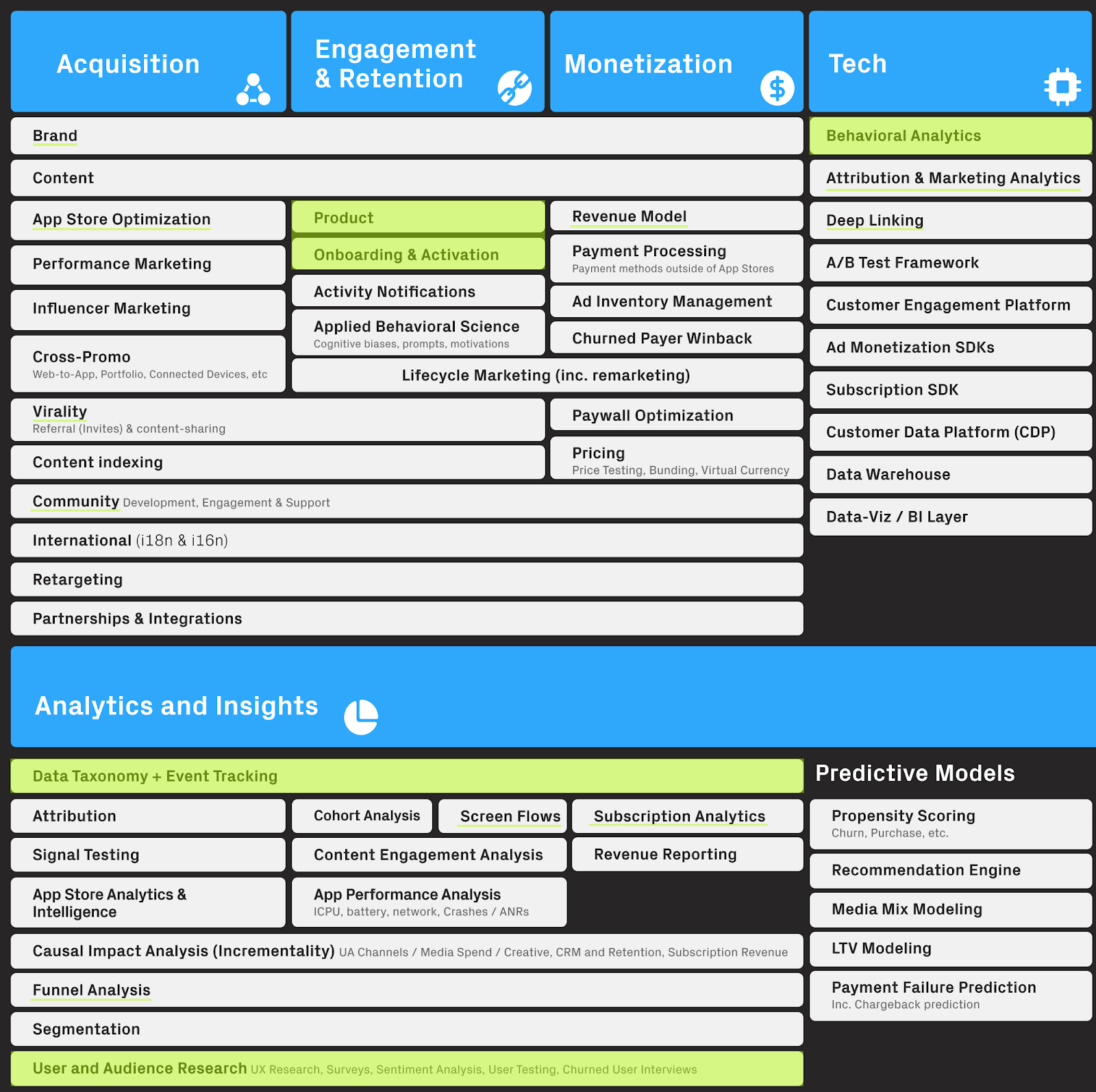Early Stage Subscription App Growth Stack
A scaled-down “MVP” of the Mobile Growth Stack to help mobile developers get started

Someone recently asked me: If I was still in the early/pre-launch stage, what are the 5 areas of growth I would focus on?
Andy Carvell’s Mobile Growth Stack has become the standard framework for growing mobile apps. (If you haven’t heard of it, both the original article and the follow-up from earlier this year are well worth a read.)
This framework lays out everything developers need to think about when building and scaling a mobile app business.
But for early-stage apps and small teams, the Mobile Growth Stack can seem overwhelming. It’s thorough, which is awesome, but for small teams that are just getting started, this can make prioritizing a challenge.
In today’s post, I’m going to lay out a scaled-down “MVP” of the Mobile Growth Stack to help mobile app developers get started.
What to focus on first
User & Audience Research
Early on, the most important thing isn’t even remotely related to tooling. You first need to understand your audience’s needs and avoid building a solution for something that isn’t really a problem. That means you should talk to your users before you build anything.
Fortunately, many ways of gathering user feedback are relatively simple and goes from free to affordable. You can immerse yourself in communities (like Reddit and Discord forums), set up Typeforms, and email or directly call people. Matthieu Rouif of Photoroom conducted user interviews by paying students and tourists in McDonald’s meals! (For the full story, check out episode 23 of the Sub Club Podcast).
As Alex Turnbull put it:
“You don’t need many tools to talk to your customers. And while it’s a time-consuming task, it’s one of the highest-ROI efforts you can tackle as a startup CEO.”
When your resources are the most scarce, that’s when it’s most important to focus your efforts on finding good product-market fit. Skipping this phase can lead to costly mistakes in both product and marketing.
Product
Once you’re confident there’s a need for your app, it’s time to start building.
This brings us to the Product block.
First and foremost, you should focus on the product itself. Obviously this is a broad focus area, but your product is the key to your success. Ask yourself: What are the key differentiators of your app? What will keep your users coming back to your app over and over again? Retention curves need to flatten at some point or there’s no tweak that will save an ever-leaking product. Build a solution that users will love, and the rest will fall into place.
Data Taxonomy & Event Tracking
To measure your progress on the Product block, you need a good sense of analytics.
You’ll want to invest some time on Data Taxonomy & Event Tracking from the beginning to make sure your data doesn’t turn into a mess. Phiture’s taxonomy spreadsheet is a good place to start.
Behavioral Analytics
Understanding how users interact with your product is crucial in the early stages. After all, if you know what is and isn’t working, you can make adjustments to improve.
While more profesional analytics tools such as Amplitude and Mixpanel offer low-cost plans for startups, many developers start with Firebase, which is free. In addition to behavioral analytics, Firebase also provides other features such as crash analytics and remote config.
Onboarding & Activation
This is where a lot of the low-hanging fruit is. By prioritizing iterations earlier in the funnel, you can gather larger cohorts and get more data faster. This will help you create a larger sample and have more confidence when you have to make tough decisions.
Check out this article for tips on setting up a great onboarding experience.
What to focus on next
Once you’ve laid a solid foundation with the first five blocks we discussed above, you can start adding more blocks into the mix.
Acquisition
I’ve been trying to convince people for 5+ years that paid acquisition isn’t the most pressing issue at the start. In many cases, you can wait to lean into some serious paid acquisition strategies until your churn rates are lower. As Eric Seufert recently mentioned on an episode of Sub Club, it’s better to understand early how performance marketing traffic reacts to the product, but in my opinion it’s not a foundational activity.
Some non-paid acquisition activities can and should be run in parallel with early development. For example: building a community before launch, testing names and taglines, and gauging paid acquisition pricing and mechanics. Not Just Your Fam: Dynamic Guide to Your First 100 Users is a great resource for brainstorming ideas for understanding your audience better and encouraging early adopters.
I’d even consider “brand” an early block, though I don’t recommend directly investing in branding campaigns too soon.
Everything else
Many other areas can be critical, both early on and later. After all, nothing is highlighted in the Mobile Growth Stack for no reason. Prioritizing means you have to cut some important blocks, to zoom in on the most fundamental pieces first. No one can do proper funnel analysis or develop a notification strategy without proper Analytics & Taxonomy in place. There’s no ASO tweak without a good understanding of user persona motivations.
Just remember: the Mobile Growth Stack is not about tools (although Phiture and TheAppFuel have great recommendations). It’s about evaluating how important each focus area is at each growth stage and helping you decide when to prioritize what. And the answer will be different for each company. For some, the most important thing is to find a revenue model before launching. Others grow to 20+ million downloads before their VCs ask for a plan to make money!
Use the 80/20 rule
Deciding whether or not to prioritize a block of the Mobile Growth Stack doesn’t have to be all or nothing. You can choose to dedicate some time to certain blocks early on but without investing too much time or effort.
For example, it might be a good idea to have a decent ASO listing from the beginning, set up some deep links, or put together a nice invitation flow to see if there’s a potential for virality. The idea is to accomplish 80% of the work in 20% of the time to find that sweet spot between effort and payoff.

There are often ways around time-consuming blocks. Take the Revenue Model block, for example. It’s possible to assess users’ propensity to pay without actually building a scoring system or payment flow. Just set up a painted-door test and wait to fully implement the feature until you’ve confirmed that your users would buy it.
I often see early-stage startups with overkill tasks on their to-do list. There’s no need to A/B test a paywall when you only get 10 free trials per day. While paywall optimization can make a big difference, it’s not worth A/B testing until you have much higher volume.
Postpone the “high effort, high impact” areas
Some blocks of the Mobile Growth Stack — like lifestyle strategies, in-app messages, and live ops — fall into the “high effort, high impact” category. While these areas have a ton of potential, they’re too costly to invest in up front.
The core product mechanics should be what drives retention at the beginning. Once the foundational blocks have been proven to work, then you should start iterating to maximize potential. (To give an extreme example: an app company I work with is currently grossing 8 figures in yearly revenue and has yet to send a single push notification!)
The exception to this is if virality is at the core of your growth model. In this case, you’ll need to prioritize this block right away because social features need to be baked into your app from the get-go.
Conclusion: The mobile growth stack MVP
Consider this approach a minimum viable version (MVP) of the Mobile Growth Stack for early-stage apps — focusing on the 5 most important areas to focus on from day one.
Just remember that all areas of the Mobile Growth Stack are important at some point. Developers looking to build sustainable long-term growth shouldn’t ignore the rest of the stack for too long.

If you liked this post, have questions, or want to discuss your early growth stack – join the conversation in the Sub Club forum, a community of likeminded app founders and developers.
You might also like
- Blog post
Gamification in apps: A complete guide to using motivation to drive real value
Daily streaks are not the solution - here are 11 better examples
- Blog post
Apple’s June 2025 EU update: one entitlement, three fees, and CTF’s 2026 sunset
What apps in the EU should do after Apple’s DMA tweak.
- Blog post
7 Meta ad testing frameworks for subscription apps
Balancing speed and accuracy with creative testing

